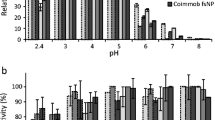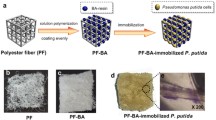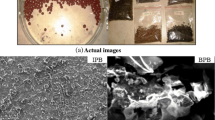Abstract
The biodegradation of waters polluted by some bisphenols, endowed with endocrine activity, has been studied by means of laccase or tyrosinase immobilized on polyacrylonitrile (PAN) beads. Bisphenol A (BPA), Bisphenol B (BPB), Bisphenol F (BPF) and Tetrachlorobisphenol A (TCBPA) have been used. The laccase-PAN beads system has been characterized as a function of pH, temperature and substrate concentration. The biochemical parameters so obtained have been compared with those of the free enzyme to evidence the modification induced by the immobilization process. Once characterized, the laccase-PAN beads have been employed in a fluidized bed reactor to determine for each of the four bisphenols the degradation rate constant (k); the τ50, i.e., the time to obtain the 50% of degradation, and the removal efficiency (RE90) after 90 min of enzyme treatment. The same parameters have been measured for each of the four pollutants with the same fluidized bed bioreactor loaded with tyrosinase-PAN beads. The internal comparison, i.e., in each of the two catalytic systems, has shown that both enzymes exhibit a removal efficiency in the following order BPF>BPA>BPB>TCBPA. The external comparison, i.e., the comparison between the two catalytic system, has shown that the catalytic power of laccase were higher than that of tyrosinase. The operational stability of both catalytic systems resulted excellent, since they maintained more than 80% of the initial activity after 30 days of work.





Similar content being viewed by others
References
Ashby J, Tinwell H (1998) Uterotrophic activity of bisphenol A in the immature rat. Environ Health Persp 106:716–720
Ashby J, Odum J, Paton D, Lefevre PA, Beresford N, Sumpter JP (2000) Re-evaluation of the first synthetic estrogen, 1-keto-1,2,3,4-tetrahydrophenanthrene, and bisphenol A, using both the ovariectomised rat model used in 1933 and additional assays. Toxicol Lett 115:231–238
Attanasio A, Diano N, Grano V, Sicuranza S, Rossi S, Bencivenga U, Fraconte L, Di Martino S, Canciglia P, Mita DG (2005) Nonisothermal bioreactors in the treatment of vegetation waters from olive oil: laccase versus syringic acid as bioremediation model. Biotechnol Progr 21:806–815
Bollag JM (1992) Decontaminating soil with enzymes. Environ Sci Technol 26:1876–1881
Buchanan ID, Nicell JA (1997) Model development for horseradish peroxidase catalyzed removal of aqueous phenol. Biotechnol Bioeng 54:251–261
Cabana H, Jiwan JLH, Rozenberg R, Elisashvili V, Penninckx M, Agathos SN, Jones JP (2007) Elimination of endocrine disrupting chemicals nonylphenol and bisphenol A and personal care product ingredient triclosan using enzyme preparation from the white rot fungus Coriolopsis polyzona. Chemosphere 67:770–778
Cabana H, Jones JP, Agathos SN (2009) Utilization of cross-linked laccase aggregates in a perfusion basket reactor for the continuous elimination of endocrine-disrupting chemicals. Biotechnol Bioeng 102:1582–1592
D’Annibale A, Rita Stazi S, Vinciguerra V, Di Mattia E, Giovannozzi Sermanni G (1999) Characterization of immobilized laccase from Lentinula edodes and its use in olive-mill wastewater treatment. Process Biochem 34:697–706
Dec J, Bollag JM (1994) Dehalogenation of chlorinated phenols during oxidative coupling. Environ Sci Technol 28:484–490
Dec J, Bollag JM (2000) Phenoloxidase-mediated interactions of phenols and anilines with humic materials. J Environ Qual 29:665–667
Diano N, Grano V, Fraconte L, Caputo P, Ricupito A, Attanasio A, Bianco M, Bencivenga U, Rossi S, Manco I, Mita L, Del Pozzo G, Mita DG (2007) Nonisothermal bioreactors in enzymatic remediation of waters polluted by endocrine disruptors: the BPA as model of pollutant. Appl Catal B Environ 69:252–261
Dodor D, Hwang H, Sin E (2004) Oxidation of anthracene and benzo[a]pyrene by immobilized laccase from Trametes versicolor. Enzyme Microb Technol 35:210–217
Durante D, Casadio R, Martelli L, Tasco G, Portaccio M, De Luca P, Bencivenga U, Rossi S, Di Martino S, Grano V, Diano N, Mita DG (2004) Isothermal and non-isothermal bioreactors in the detoxification of waste waters polluted by aromatic compounds by means of immobilised laccase from Rhus veinicifera. J Mol Catal B Enzym 27:191–206
Elsby R, Maggs JL, Ashby J, Park BK (2001) Comparison of the modulatory effects of human and rat liver microsomal metabolism on the estrogenicity of bisphenol A: implications for extrapolation to humans. J Pharmacol Exp Ther 297:103–113
Filazzola M, Sannino F, Rao M, Gianfreda L (1999) Effect of various pollutants and soil-like constituents on laccase from Cerrena unicolor. J Environ Qual 28:1929–1938
Fukazawa H, Hoshino K, Shiozawa T, Matsushita H, Terao Y (2001) Identification and quantification of chlorinated bisphenol A in wastewater from wastepaper recycling plants. Chemosphere 44:973–979
Fukazawa H, Watanabw M, Shiraishi F, Shiraishi H, Shiozawa T, Matsushita H, Terao Y (2002) Formation of chlorinated derivatives of bisphenol A in waste paper recycling plants and their estrogenic activities. J Health Sci 48:242–249
Fukuda T, Uchida H, Takashima Y, Uwajima T, Kawabata T, Suzuki M (2001) Degradation of bisphenol A by purified laccase from Trametes villosa. Biochem Biophys Res Commun 284:704–706
Gaido KW, Leonard LS, Lovell S, Gould JC, Babai D, Portier CJ, McDonnell DP (1997) Evaluation of chemicals with endocrine modulating activity in a yeast-based steroid hormone receptor gene transcription assay. Toxicol Appl Pharm 143:205–212
Galliker P, Hommes G, Schlosser D, Corvini PFX, Shahgaldian P (2010) Laccase-modified silica nanoparticles efficiently catalyze the transformation of phenolic compounds. J Colloid Int Sci 349:98–105
Georgieva S, Godjevargova T, Portaccio M, Lepore M, Mita DG (2008) Advantages in using non-isotermal bioreactors in bioremediation of water polluted by phenol by means of immobilized laccase from Rhus vernicifera. J Molecular Catal B Enzym 55:177–184
Helleday T, Tuominen KL, Bergman A, Jenssen D (1999) Brominated flame retardants induce intragenic recombination in mammalian cells. Mutat Res 439:137–147
Ikehata K, Nicell JA (2000) Characterization of tyrosinase for the treatment of aqueous phenols. Biores Technol 74:191–199
Ispas CR, Ravalli MT, Steere A, Andreescu S (2010) Multifunctional biomagnetic capsules for easy removal of phenol and bisphenol A. Water Res 44:1961–1969
Kim YJ, Nicell JA (2006a) Laccase-catalyzed oxidation of bisphenol A with the aid of additives. Process Biochem 41:1029–1037
Kim YJ, Nicell JA (2006b) Impact of reaction conditions on the laccase-catalyzed conversion of bisphenol A. Biores Technol 97:1431–1442
Kim HS, Han SY, Yoo SD, Lee BM, Park KL (2001) Potential estrogenic effects of bisphenol-A estimated by in vitro and in vivo combination assays. J Toxicol Sci 26:111–118
Kitamura S, Ohmegi M, Sanoh S, Sugihara K, Yoshihara S, Fujimoto N, Ohta S (2003) Estrogenic activity of styrene oligomers after metabolic activation by rat liver microsomes. Environ Health Persp 111:329–334
Kitamura S, Suzuki T, Sanoh S, Kohta R, Jinno N, Sugihara K, Yoshihara S, Fujimoto N, Watanabe H, Ohta S (2005) Comparative study of the endocrine-disrupting activity of bisphenol A and 19 related compounds. Toxicol Sci 84:249–259
Krishnan AV, Stathis P, Permuth SF, Tokes L, Feldman D (1993) Bisphenol-A: an estrogenic substance is released from polycarbonate flasks during autoclaving. Endocrinology 132:2279–2286
Kuruto-Niwa R, Terao Y, Nozawa R (2002) Identification of estrogenic activity of chlorinated bisphenol A using a GFP expression system. Environ Toxicol Pharm 12:27–35
Lante A, Crapisi A, Krastanov A, Spettoli P (2000) Biodegradation of phenols by laccase immobilised in a membrane reactor. Process Biochem 36:51–58
Lowry OH, Rosebrough NJ, Farr AL, Randall RJ (1951) Protein measurement with the Folin phenol reagent. J Biol Chem 193:265–275
Marin-Zamora ME, Rojas-Melgarejo F, Garcia-Canovas F, Garcia-Ruiz PA (2007) Effects of the immobilization supports on the catalytic properties of immobilized mushroom tyrosinase: a comparative study using several substrates. J Biotechnology 131:388–396
Matthews JB, Twomey K, Zacharewski TR (2001) In vitro and in vivo interactions of bisphenol A and its metabolite, bisphenol A glucuronide, with estrogen receptors alpha and beta. Chem Res Toxicol 14:149–157
Mita L, Sica V, Guida M, Nicolucci T, Grrimaldi T, Caputo L, Bianco M, Rossi S, Bencivenga U, Mohy Eldin MS, Tufano MA, Mita DG, Diano N (2010) Employment of immobilised lipase from Candida rugosa for the bioremediation of waters polluted by dimethylphthalate, as a model of endocrine disruptors. J Mol Catal B Enzym 62:133–141
Moeder M, Martin C, Koeller G (2004) Degradation of hydroxylated compounds using laccase and horseradish peroxidase immobilized on microporous polypropylene hollow fiber membranes. J Membrane Sci 245:183–190
Nakagawa Y, Suzuki T (2001) Metabolism of bisphenol A in isolated rat hepatocytes and oestrogenic activity of a hydroxylated metabolite in MCF-7 human breast cancer cells. Xenobiotica 31:113–123
Olsen CM, Meussen-Elholm ET, Samuelsen M, Holme JA, Hongslo JK (2003) Effects of the environmental oestrogens bisphenol A, tetrachlorobisphenol A, tetrabromobisphenol A, 4-hydroxybiphenyl and 4, 4’-dihydroxybiphenyl on oestrogen receptor binding, cell proliferation and regulation of oestrogen sensitive proteins in the human breast cancer cell line MCF-7. Pharmacol Toxicol 92:180–188
Pottenger LH, Domoradzki JY, Markham DA, Hansen SC, Cagen SZ, Waechter JM Jr (2000) The relative bioavailability and metabolism of bisphenol A in rats is dependent upon the route of administration. Toxicol Sci 54:3–18
Qiu L, Huang Z (2010) The treatment of chlorophenols with laccase immobilized on sol-gel-derived silica. World J Microbiol Biotechnol 26:775–781
Rasera K, Ferla J, Dillon AJP, Riveiros R, Zeni M (2009) Immobilization of laccase from Pleurotus sajor-caju in polyamide membranes. Desalination 245:657–661
Saito T, Kato K, Yokogawa Y, Nishida M, Yamashita N (2004) Detoxification of bisphenol A and nonylphenol by purified extracellular laccase from a fungus isolated from soil. J Biosci Bioeng 98:64–66
Sjodin A, Carlsson H, Thuresson K, Sjolin S, Bergman A, Ostman C (2001) Flame retardants in indoor air at an electronics recycling plant and at other work environments. Environ Sci Technol 35:448–454
Snyder RW, Maness SC, Gaido KW, Welsch F, Sumner SC, Fennell TR (2000) Metabolism and disposition of bisphenol A in female rats. Toxicol Appl Pharmacol 168:225–234
Sun H, Shen OX, Wang XR, Zhou L, Zhen SQ, Chen XD (2009) Anti-thyroid hormone activity of bisphenol A, tetrabromobisphenol A and tetrachlorobisphenol A in an improved reporter gene assay. Toxicol In Vitro 23(5):950–954
Synder SA, Westerhoff P, Yoon Y, Sedlak DL (2003) Metabolism and disposition of bisphenol A in female rats. Toxicol Appl Pharmacol 168:225–234
Tamura A, Satoh E, Kashiwada A, Matsuda K, Yamada K (2010) Removal of alkylphenols by the combined use of tyrosinase immobilized on ion-exchange resins and chitosan beads. J Appl Polym Sci 115(1):137–145
Thomsen C, Janak K, Lundanes E, Becher G (2001) Determination of phenolic flame-retardants in human plasma using solid-phase extraction and gas chromatography-electron-capture mass spectrometry. J Chromatogr B Biomed Sci Appl 750:1–11
Tinwell H, Joiner R, Pate I, Soames A, Foster J, Ashby J (2000) Uterotrophic activity of bisphenol A in the immature mouse. Regul Toxicol Pharmacol 32:118–126
Tsutsumi Y, Haneda T, Nishida T (2001) Removal of estrogenic activities of bisphenol A and nonylphenol by oxidative enzymes from lignin-degrading basidiomycetes. Chemosphere 42:271–276
Uchida H, Fukuda T, Miyamoto H, Kawabata T, Suzuki M, Uwajima T (2001) Polymerization of bisphenol A by purified laccase from Trametes villosa. Biochem Biophys Res Commun 287:355–358
Zhang J, Liu X, Xu Z, Chen H, Yang Y (2008) Degradation of chlorophenols catalyzed by laccase. Int Biodeter Biodegr 61:351–356
Acknowledgments
This work has been carried out under the cooperation agreement between the University “Prof. Dr. Assen Zlatarov” of Burgas (Bulgaria) and the Italian Interuniversity Consortium “National Institute for Biostructures and Biosystems” (INBB). This work was also supported by scientific research sector of University “Prof. Dr Assen Zlatarov” of Burgas, by the Italian Ministry of Health/ISPESL under the National Strategic Project “Salute della donna”, by the Italian Ministry of Health/ISZM (Portici-Italy) and by the MIUR through a PRIN project (Funds 2008—Diano).
Author information
Authors and Affiliations
Corresponding author
Rights and permissions
About this article
Cite this article
Nicolucci, C., Rossi, S., Menale, C. et al. Biodegradation of bisphenols with immobilized laccase or tyrosinase on polyacrylonitrile beads. Biodegradation 22, 673–683 (2011). https://doi.org/10.1007/s10532-010-9440-2
Received:
Accepted:
Published:
Issue Date:
DOI: https://doi.org/10.1007/s10532-010-9440-2




